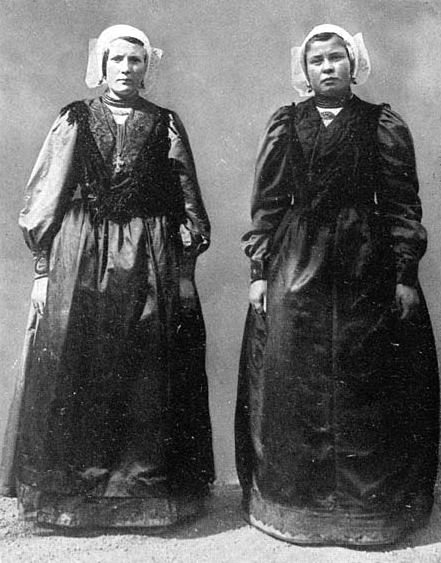I have been fascinated by traditional costume for as long as I can remember. Not only the Dutch traditional costume, but from countries all over the globe. Whenever I travel, I always try to find something of the regional clothing. It can be shoes, a handbag, jewelry, a hat or an element of the clothing, for men or women.
Vaguely I remember cycling to my grandmother on Sundays, together with my mom. Grandma was dressed in traditional clothing every day and it made her look very impressive. Together with my grandfather, she lived in the village they were born and had grown up in and there a lot of the older people were still wearing the lace caps, embroidered vests and I don’t know how many skirt piled over each other. Strangely enough I don’t remember much of my grandfathers clothes, but I think it was traditional too.
Through the years, many designers have been inspired by traditional clothing.Cristóbal Balenciaga was influenced by the Spanish folk tradition, being from Spain himself, but other designers were also influenced by clothes from all different countries. John Galliano and Alexander McQueen produced several collections inspired by China, Mongolia, Japan, Russia, etc. And in 2007, Viktor & Rolf created a collection on Dutch folk costume: tapestries, checks, and pure white buttoned-up blouses, their fall 2007 collection.
Dutch Traditional Costume from different districts
.
Viktor & Rolf fall 2007 ready-to-wear collection
.
most pictures in this post come from: http://www.gutenberg.org/files/20665/20665-h/20665-h.htm and www.style.com
.








































What village did your grandmother and grandfather live in? What was their occupation?Were they Catholic or Protestant? I know that religion and occupation, which typically coincided with what village they were from, largely influenced what Dutch peasants wore.
My great-grandmother is from the Netherlands from Appledorn. Do you have any photos of traditional costumes from that place? Thank you
Hi Mina,
I found a few pictures of people in traditional costumes of Apeldoorn
What’s your mail-adres? I’ll send them to you,
With regards,
Netty
Some of the women pictured have attached to their forehead small rectangular pieces of metal that seem to float in the air looking like mirrors worn by bicyclists. What are they and what is their function?
Ear irons are worn in Staphorst, Groningen, Friesland and Drenthe, on Urk and in Zeeland. An ear iron is a typical Dutch “attachment”. A bracket that clamps around the head and to which you can attach a lace hat. Under the ear iron and the lace hat, a (mostly black) lower hat was worn. This way, the lace hat stayed clean longer.
Ear irons have been worn since the 16th century. Originally, the ear iron was a bent iron thread that ran under the hair at the back of the head and pressed against the cheeks. On Urk, an ear iron is worn that most closely resembles the original ear iron.
At the ends, the ear iron had buttons so that the sharp iron did not sting the face. The iron rusted in humid weather, which is why materials were later used that were more resistant to the Dutch climate.
The clamp was not only used as a functional tool, but also as a showpiece jewel. The buttons became a piece of jewelry in the form of bird heads or snakes. Behind the decorated end were holes through which pins could be inserted to secure the hat. Those pins were also used to show off.
In the north of the country, the ear iron bracket grew so wide until it enclosed almost the entire head. Of course, such a valuable ear iron was worn only by rich people who could afford it. Jewelry and ear irons were status symbols that you could show off. Peasant workers and poor people wore at most a narrow copper or silver ear iron or even just a headscarf.
First ear iron
An important moment. Your first ear iron.
Around the age of 18, Friezin received her first ear iron from a rich age. The long hair, which was always under a hat, was then cut off.